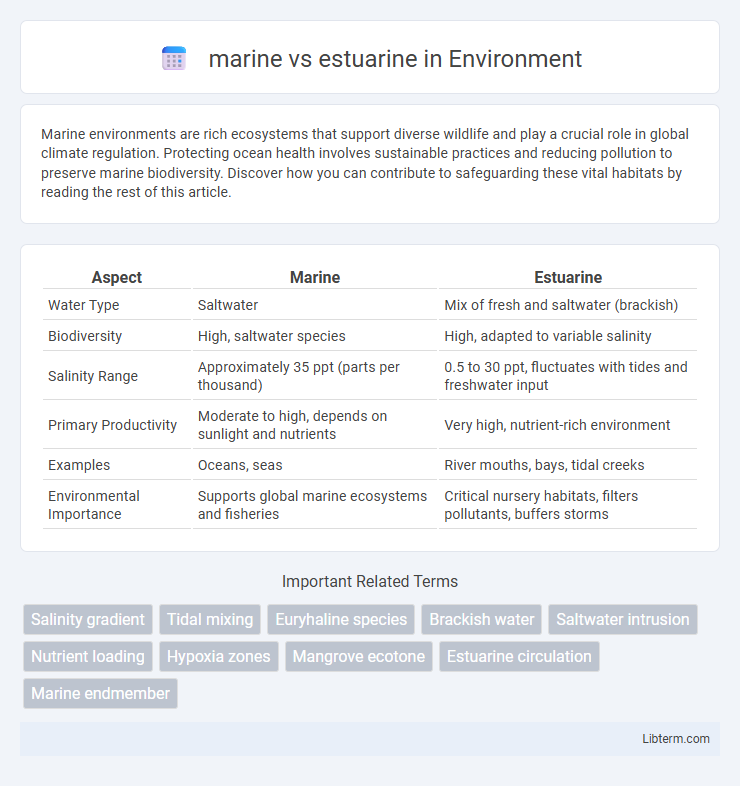Marine environments are rich ecosystems that support diverse wildlife and play a crucial role in global climate regulation. Protecting ocean health involves sustainable practices and reducing pollution to preserve marine biodiversity. Discover how you can contribute to safeguarding these vital habitats by reading the rest of this article.
Table of Comparison
| Aspect | Marine | Estuarine |
|---|---|---|
| Water Type | Saltwater | Mix of fresh and saltwater (brackish) |
| Biodiversity | High, saltwater species | High, adapted to variable salinity |
| Salinity Range | Approximately 35 ppt (parts per thousand) | 0.5 to 30 ppt, fluctuates with tides and freshwater input |
| Primary Productivity | Moderate to high, depends on sunlight and nutrients | Very high, nutrient-rich environment |
| Examples | Oceans, seas | River mouths, bays, tidal creeks |
| Environmental Importance | Supports global marine ecosystems and fisheries | Critical nursery habitats, filters pollutants, buffers storms |
Introduction to Marine and Estuarine Ecosystems
Marine ecosystems are vast, saltwater environments such as oceans and coral reefs, characterized by high salinity and diverse species adapted to stable saline conditions. Estuarine ecosystems occur where freshwater from rivers meets and mixes with saltwater from the sea, creating brackish water environments rich in nutrients and supporting unique communities of plants and animals. These ecosystems play vital roles in carbon cycling, nutrient trapping, and serve as crucial breeding and nursery habitats for many aquatic species.
Defining Marine and Estuarine Environments
Marine environments are characterized by saline ocean waters with stable salinity levels, supporting ecosystems such as coral reefs, kelp forests, and deep-sea habitats. Estuarine environments occur where freshwater from rivers meets and mixes with ocean saltwater, creating brackish conditions that foster highly productive habitats like salt marshes and mangrove swamps. These transitional zones experience fluctuating salinity levels and tidal influences, making them critical nurseries for many marine species and hotspots for biodiversity.
Key Differences in Water Composition
Marine water contains high salinity levels averaging around 35 parts per thousand, dominated by sodium chloride and stable mineral content, while estuarine water exhibits variable salinity ranging from 0.5 to 30 parts per thousand due to the mixing of freshwater and seawater. The concentration of dissolved oxygen in marine environments remains relatively consistent, whereas estuarine waters experience fluctuations influenced by tidal flow and freshwater input. Nutrient levels in estuaries are generally higher, supporting diverse biological productivity compared to the more nutrient-limited marine systems.
Biodiversity: Marine vs. Estuarine Species
Marine environments host greater species diversity due to stable saline conditions and expansive habitats like coral reefs, supporting diverse fish, mollusks, and marine mammals. Estuarine ecosystems feature unique biodiversity adapted to fluctuating salinity and nutrient-rich waters, including various species of crabs, oysters, and migratory birds. These estuaries serve as crucial nurseries for many marine species, enhancing overall coastal biodiversity.
Physical and Chemical Characteristics
Marine environments feature high salinity levels averaging around 35 ppt, stable temperature ranges, and consistent water density influenced by oceanic currents. Estuarine systems exhibit variable salinity, fluctuating between 0.5 to 30 ppt due to the mixing of freshwater and seawater, alongside increased nutrient concentrations and turbidity from riverine input. Physical conditions such as sediment deposition and tidal cycles create dynamic chemical gradients in estuaries, affecting oxygen levels and pH variability.
Adaptations of Organisms in Each Habitat
Marine organisms exhibit adaptations such as salt excretion glands and streamlined bodies to thrive in high salinity and open water conditions, while estuarine species develop osmoregulatory capabilities to cope with fluctuating salinity levels. Fish in estuaries often display morphological plasticity and tolerance to variable oxygen concentrations, unlike marine species adapted for stable, high-salinity environments. Structural adaptations like flexible gill membranes and specialized feeding appendages enable estuarine organisms to survive in the dynamic, nutrient-rich waters characteristic of these habitats.
Ecological Roles and Functions
Marine ecosystems support diverse habitats like coral reefs and open oceans, serving as critical carbon sinks and stabilizing global climate. Estuarine environments, where freshwater meets saltwater, act as nurseries for many fish species, enhance nutrient cycling, and improve water quality through natural filtration. Both ecosystems are essential for maintaining biodiversity and sustaining fisheries that support coastal economies.
Human Impacts and Environmental Threats
Marine and estuarine environments face significant human impacts, including pollution from industrial discharge, agricultural runoff, and urbanization, which lead to habitat degradation and loss of biodiversity. Overfishing and coastal development disrupt the delicate balance of estuarine ecosystems, while marine areas suffer from oil spills, plastic debris accumulation, and ocean acidification. Both ecosystems are increasingly threatened by climate change, causing sea-level rise, altered salinity patterns, and increased frequency of extreme weather events that exacerbate habitat vulnerability.
Conservation Strategies for Both Ecosystems
Marine and estuarine ecosystems require tailored conservation strategies due to their unique ecological characteristics and threats. Marine conservation focuses on protecting open ocean habitats through marine protected areas (MPAs), sustainable fishing regulations, and pollution control to maintain biodiversity and prevent overexploitation. Estuarine conservation prioritizes habitat restoration, such as wetland rehabilitation and controlling freshwater inflows, to support critical nursery grounds and improve water quality affected by urban runoff and sedimentation.
Future Perspectives and Research Directions
Future research in marine and estuarine ecosystems emphasizes the integration of advanced remote sensing technologies and machine learning to enhance monitoring of biodiversity and pollutant dynamics. There is growing importance in investigating climate change impacts on species distribution and ecosystem resilience, particularly in transitional zones where marine and estuarine environments overlap. Studies aiming to develop adaptive management frameworks will be crucial for balancing conservation efforts with sustainable resource use amid escalating anthropogenic pressures.
marine Infographic

 libterm.com
libterm.com